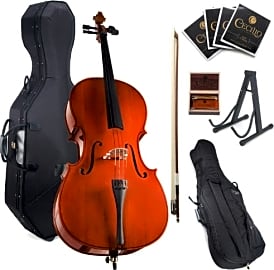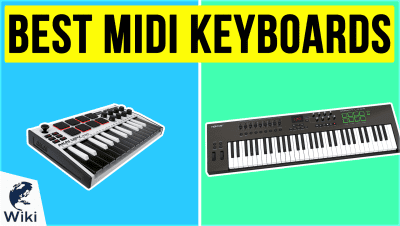The 10 Best Cellos

This wiki has been updated 37 times since it was first published in September of 2015. Let's face it, not every cellist can afford a custom or vintage instrument handmade by a world-renowned luthier, and beginners should not spend the money on one even if they could. For those of us living in reality, here is a selection of fine cellos in a range of quality and costs that are perfect for everyone from the student just getting started to the experienced orchestra member. When users buy our independently chosen editorial selections, we may earn commissions to help fund the Wiki.
Editor's Notes
February 23, 2020:
We took a close look at the models available on the market and wanted to make sure our list was representative of the wide variety in quality and price available. That said, we didn't want to include a lot of budget student models, as we already have a list devoted to student cellos. One of the few student models we did include is the DZ Strad 101, which is a little expensive for individuals just starting out, but that makes a really smart selection for school orchestra programs, as it will offer excellent tone and playability, so young musicians will be encouraged early on to continue in their studies.
Among the more pro-oriented options on our list, you'll find the D Z Strad Model 400 and the electric Yamaha SVC-110SK Silent. Now, there is a bit of a ceiling to the sound quality you're going to get from an electric model, but this Yamaha also has three built-in reverb settings to create a sense of the room you'd normally get by the sound of an instrument bouncing off the walls. It also seems capable of creating some subtle overtones that less expensive models can't manage.
To make room for some of these new models, we said goodbye to the likes of the Crescent Starter Kit and the Merano MC150, both of which struggles with durability. The Merano also had a tough time staying in tune due to poorly designed pegs.
How A Cello Makes Its Sound
A cellist can produce extremely short, millisecond sounds or they can draw a note out for several minutes.
A sound is created by vibrations that your inner ear structure translates into different tones. These vibrations either move through air or water (usually air, in the case of instruments) and make oscillating sound waves. The frequency of the sound wave alters how it sounds. In a cello, the vibrations occur on the strings that are usually made from either chromium, aluminum, titanium or a combination of each. As the cello player plucks their strings, they send vibrations across them. Depending on the thickness of the string, it may vibrate quicker or slower, resulting in different pitches from very high to very deep.
One can think of this process like pulling a rubber band taught and flicking their finger against it; the thicker rubber bands make drastically different sounds than the thin ones. If you watch a cellist, you'll notice that they often press their strings against the fingerboard. By doing this, they shorten the part of the string that is still elevated so that it cannot vibrate as much, and creates a higher sound. While a cello may not have the largest range of the orchestral family, between its four strings, and countless places the cellist can press down on them, it can create a variety of sounds.
Besides high or low pitches, there is the matter of longer or shorter notes. A cellist can produce extremely short, millisecond sounds or they can draw a note out for several minutes. They achieve the shorter sounds by plucking the strings with their fingers, which is a playing technique called pizzicato. Cellists create longer notes by using their bow. Since a bow can continually vibrate a string for as long as its fibers move across it, it's capable of engaging it far longer than the human finger can.
What To Look For In A Cello
Choosing a cello is a bit more complex than selecting other types of instruments because one must take their full arm, body and leg lengths into account. That is why student cellos are usually made from cheaper materials; the player will outgrow their instrument in a few years and doesn't want to spend too much money on it. Adult players can invest in more high-end cellos.
Once you've found the best cello for your playing level and comfort, there are a few other details to look for.
If you're buying your first cello, consult someone who is fully knowledgeable on the measurements of the instrument. There's much more to consider besides the height of the instrument; one must also think about the widths of the bouts and the neck shape. Each of these components affects how comfortable the cellist is. The cellists' body interacts with their instrument a lot so it's important to be completely content with the feel of their instrument. Otherwise, they will be distracted and won't focus on their music.
Once you've found the best cello for your playing level and comfort, there are a few other details to look for. Make sure you get a sturdy case for your instrument. Look for an exterior that is very hard so it won't dent if you drop it, and an interior that has injection-molded foam to hug your cello, ensuring it doesn't shift during travel. Then, of course, there is the bow which has its own important criteria to look for.
The History Of The Cello
The cello is a part of the violin family, which is why one of the first versions was called the violoncello. In Italian, that translates to the "big little violin." The instrument came out in the mid 16th century, and one of its first famous builders was Andrea Amati. Amati made cellos for the King of France, Charles IX. Composers didn't begin writing music specifically for the cello for several decades after its creation. Until then, cellists would simply play music written for the violin, but in a lower octave.
The cello wasn't a star instrument until the late 1600s when wire wrapped strings came to be. Before then, the cello was mostly used as harmonic or bass accompaniment. Johann Sebastian Bach is credited with making the cello very popular, with his six suites written specifically for the instrument. But before Bach took an interest in the cello, composers Giovanni Battista Degli Antonii and Domenico Gabrielli were writing music for it.
Cello players haven't always had the luxury of standing their instrument upon the ground via a small peg. Early cellists, like those of the Baroque era, would have to hold this massive instrument between their calves. It's even believed that some early cellists held the instrument over their shoulders.















